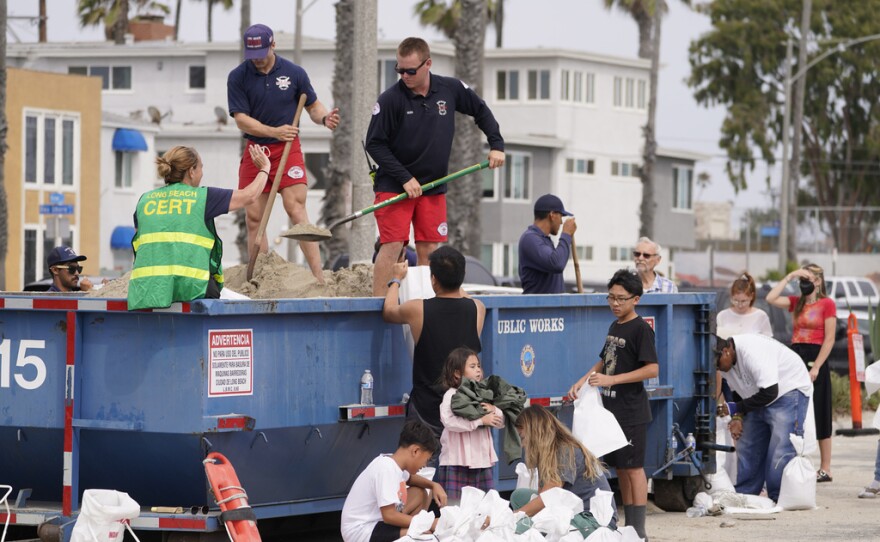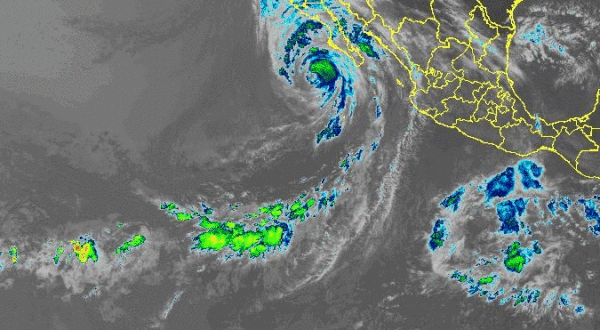Hurricane Hilary roared toward Mexico’s Baja California peninsula late Saturday as a downgraded but still dangerous Category 2 hurricane likely to bring “catastrophic” flooding to the region and cross into the southwestern U.S. as a tropical storm.
Meteorologists warned that despite weakening, the storm remained treacherous.
One person drowned Saturday in the Mexican town of Santa Rosalia, on the peninsula’s eastern coast, when a vehicle was swept away in an overflowing stream. Rescue workers managed to save four other people, said Edith Aguilar Villavicencio, the mayor of Mulege township.
It was not immediately clear whether officials considered the fatality related to the hurricane, but video posted by local officials showed torrents of water coursing through the town’s streets.
Emergency resources
- Sandbag pickup locations available here. Call these numbers to check for availability first.
- Information on road closures
- SDG&E power outage map
- Reporting road-related issues
- National Weather Service
- Tips for driving in the rain
Forecasters said the storm was still expected to enter the history books as the first tropical storm to hit Southern California in 84 years, bringing flash floods, mudslides, isolated tornadoes, high winds and widespread power outages.
California Gov. Gavin Newsom proclaimed a state of emergency, and officials had urged people to finish their preparations before sundown Saturday. It would be too late by Sunday, one expert said.
The hurricane is the latest major climate disaster to wreak havoc across the U.S., Canada and Mexico. Hawaii’s island of Maui is still reeling from last week's blaze that killed over 100 people and ravaged the historic town of Lahaina, making it the deadliest U.S. wildfire in more than a century. In Canada, firefighters on Saturday continued to battle blazes during the nation’s worst fire season on record.
Hilary brought heavy rain and flooding to Mexico and the southwestern U.S. on Saturday, ahead of the storm's expected Sunday border crossing. Forecasters warned it could dump up to 10 inches (25 centimeters) — a year's worth of rain for some areas — in southern California and southern Nevada.
“This does not lessen the threat, especially the flood threat,” Jamie Rhome, the U.S. National Hurricane Center’s deputy director, said during a Saturday briefing to announce the storm’s downgraded status. “Don’t let the weakening trend and the intensity lower your guard.”
Meteorologists also expected the storm to churn up “life-threatening” surf and rip currents, including waves up to 40 feet (12 meters) high, along Mexico’s Pacific coast. Dozens sought refuge at storm shelters in the twin resorts of Los Cabos at the southern tip of the Baja peninsula, and firefighters rescued a family in San Jose del Cabo after the resort was hit by driving rain and wind.
In Tijuana, fire department head Rafael Carrillo voiced the fear at the back of everyone’s mind in the border city of 1.9 million people, particularly residents who live in homes on steep hillsides.
”If you hear noises, or the ground cracking, it is important for you to check it and get out as fast as possible, because the ground can weaken and your home could collapse,” Carrillo said.
Storm safety tips
- Stay informed. Monitor television and radio for flood watches or warnings.
- Keep your gas tank full in case of evacuation or power outages.
- Use sandbags to divert water.
- Do not walk, swim or drive through flood waters. Just six inches of fast-moving water can knock you down and one foot of moving water can sweep your vehicle away.
- Do not touch electrical equipment if it is wet or if you are standing in water. If you see a downed power line, call 911 and (800) 411-SDGE to report it. If someone has come in contact with electrical equipment, don't touch them.
- Keep a written list of emergency contacts.
- Make a plan in case of an emergency. Speak with family, friends and/or neighbors who can help ahead of time. If you rely on electrically operated medical equipment, make a plan for backup power.
- If you smell gas or suspect a gas leak, leave the area. Call 911 or SDG&E at (800) 611-7343.
- Secure outdoor items to prevent them from flying away.
- Gather supplies such as food, water and a flashlight to last at least three to five days.
- Call 211 for information including on disaster resources available 24 hours a day in over 200 languages.
Sources: Ready.gov, County of San Diego Office of Emergency Services, 211 San Diego, SDG&E.
Tijuana ordered all beaches closed Saturday, and set up a half dozen storm shelters at sports complexes and government offices.
Mexico’s navy evacuated 850 people from islands off the Baja coast, and deployed almost 3,000 troops for emergency operations. In La Paz, the picturesque capital of Baja California Sur state on the Sea of Cortez, police patrolled closed beaches to keep swimmers out of the whipped-up surf.
The U.S. hurricane center posted tropical storm and potential flood warnings for Southern California from the Pacific coast to interior mountains and deserts. The San Bernardino County sheriff issued evacuation warnings for several mountain and foothill communities ahead of the storm, while Orange County sent out its own alert for anyone living in a wildfire burn scar in the Santa Ana Mountains' Silverado and Williams canyons.
An evacuation advisory for the tourist destination of Santa Catalina Island, 23 miles (37 kilometers) off the Southern California coast, urged residents and beachgoers to leave, while authorities in Los Angeles scrambled to get the homeless off the streets and into shelters.
Across the region, municipalities ran out of free sandbags and grocery shelves emptied out as residents stockpiled supplies. The U.S. National Park Service closed California’s Joshua Tree National Park and Mojave National Preserve to keep visitors from becoming stranded amid flooding.
Major League Baseball rescheduled three Sunday games in Southern California, moving them to Saturday as part of split doubleheaders, and SpaceX delayed the launch of a satellite-carrying rocket from a base on California’s central coast until at least Monday.
The White House said President Joe Biden had been briefed on the latest preparedness plans ahead of the hurricane's turn to the U.S. “I urge everyone, everyone in the path of this storm, to take precautions and listen to the guidance of state and local officials,” he said.
Hilary on Friday had rapidly grown into an exceedingly dangerous Category 4 major hurricane, with its top sustained winds peaking at 145 mph (230 kph). Its winds dropped to 115 mph (185 kph) early Saturday as a Category 3 storm, before further weakening to 100 mph (161 kph) as a Category 2.
By late afternoon Saturday, it was centered 600 miles (965 kilometers) south-southeast of San Diego, California. Moving north-northwest at 17 mph (28 kph), the storm was expected to turn more toward the north and pick up forward speed.
The hurricane was expected to brush past Punta Eugenia on the Pacific coast before making a nighttime landfall along a sparsely populated area of the peninsula about 200 miles (330 kilometers) south of the Pacific port city of Ensenada.








